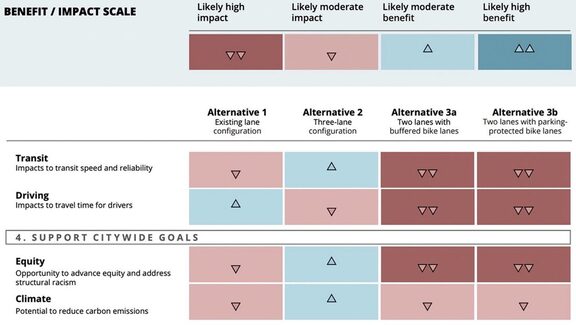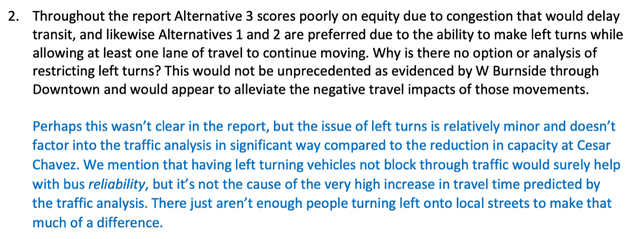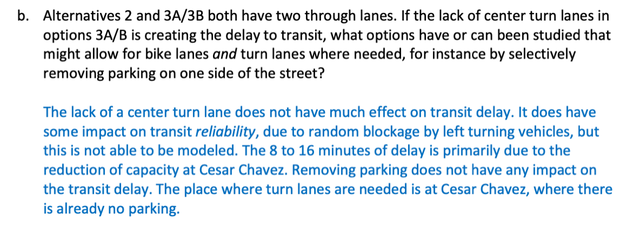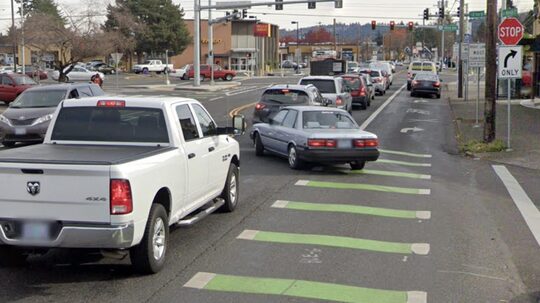Or: Why PBOT's Alternatives Evaluation is Incredibly Misleading
If you took PBOT’s Paint and Pave Survey last fall—or looked at their Alternatives Evaluation recently—you may have noticed that they gave the alternative with protected bike lanes (“Alternative 3b”) their lowest possible score for Climate and Equity:
How is it possible that protected bike lanes—bike lanes!—are bad for our city's goal of reducing carbon emissions? And how it possible that protected bike lanes harm efforts to "advance equity and address structural racism" when they provide a safe, fast, and affordable alternative to driving and transit for low-income and BIPOC people coming from East Portland?
In September 2020, the Bicycle Advisory Committee posed a series of questions to PBOT's Pave and Paint team in order to answer these questions. In the Q&A (or if you read the Evaluations Report with a very keen eye), PBOT makes it crystal clear that their claims of protected bike lanes scoring poorly for Climate and Equity were based entirely on one thing: An 8-16 minute transit delay.
In September 2020, the Bicycle Advisory Committee posed a series of questions to PBOT's Pave and Paint team in order to answer these questions. In the Q&A (or if you read the Evaluations Report with a very keen eye), PBOT makes it crystal clear that their claims of protected bike lanes scoring poorly for Climate and Equity were based entirely on one thing: An 8-16 minute transit delay.
An assumption you might make is that this [projected] transit delay for Alternative 3b is a result of not having a center turn lane (included in Alternative 2 at the expense of safe bike infrastructure—the street isn't wide enough for both), which would allow drivers to turn left without making buses wait behind them.
But your assumption would be false. According to PBOT engineers, the turn lanes make no significant difference to transit travel times:
But your assumption would be false. According to PBOT engineers, the turn lanes make no significant difference to transit travel times:
So what’s causing that 8-16 minute transit delay, if not the lack of a center turn lane?
PBOT engineers go on to reveal that their [projected] delay is caused entirely by their failure to consider a mixing zone at just one intersection:
PBOT engineers go on to reveal that their [projected] delay is caused entirely by their failure to consider a mixing zone at just one intersection:
To summarize:
1. PBOT has assigned poor Climate and Equity scores to protected bike lanes
2. These poor scores are entirely the result of projected transit delays (based on pre-COVID peak traffic counts, by the way)
3. This projected transit delay is entirely based on just one intersection, where designing a turning pocket for buses (at this one intersection, not throughout the entire corridor) would eliminate the 8-16 projected transit delay...entirely.
Okay, so why don’t we build the protected bike lanes and simply add turn lanes for buses at Chavez to reduce delays?
PBOT says this is entirely possible, with the only tradeoff being that to make space for those turn lanes, the protected bike lanes would need to become mixing zones at the intersection. This is a mixing zone:
1. PBOT has assigned poor Climate and Equity scores to protected bike lanes
2. These poor scores are entirely the result of projected transit delays (based on pre-COVID peak traffic counts, by the way)
3. This projected transit delay is entirely based on just one intersection, where designing a turning pocket for buses (at this one intersection, not throughout the entire corridor) would eliminate the 8-16 projected transit delay...entirely.
Okay, so why don’t we build the protected bike lanes and simply add turn lanes for buses at Chavez to reduce delays?
PBOT says this is entirely possible, with the only tradeoff being that to make space for those turn lanes, the protected bike lanes would need to become mixing zones at the intersection. This is a mixing zone:
Mixing zones aren’t great. They’re much less safe than protected intersections. But if a mixing zone at Chavez allows us to build protected bike lanes and preventing transit delays from occurring--thereby eliminating the report's alleged Equity and Climate concerns—then a mixing zone at Chavez is exactly what's needed.






